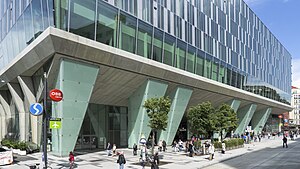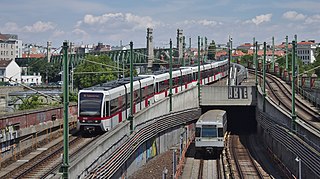
The Vienna U-Bahn, where U-Bahn is an abbreviation of the German word Untergrundbahn, is a rapid transit system serving Vienna, Austria. The five-line network consists of 83.1 kilometers (51.6 mi) of route, serving 109 stations. 459.8 million passengers rode the U-Bahn in 2019.

The Nuremberg U-Bahn is a rapid transit system run by Verkehrs-Aktiengesellschaft Nürnberg, which itself is a member of the Verkehrsverbund Großraum Nürnberg. The Nuremberg U-Bahn is Germany's newest metro system, having begun operation in 1972, although the Nuremberg-Fürth route (U1) uses part of the right of way of the Bavarian Ludwig Railway, Germany's first passenger railway opened in 1835. The current network of the U-Bahn is composed of three lines, serving 49 stations, and comprising 38.2 kilometres (23.7 mi) of operational route, making it the shortest of the four metro systems in Germany, behind Berlin, Hamburg and Munich.

Vienna has an extensive transport system that includes roads, railways, trams, metro, and buses.

The Vienna S-Bahn is a suburban commuter rail network in Vienna, Austria. As opposed to the city-run urban metro network, the Vienna U-Bahn, it extends beyond the borders of the city, is operated by the ÖBB, and consists of many branch lines. S-Bahn is short for Schnellbahn, which can be translated as "rapid railway".

Wien Südbahnhof was Vienna's largest railway terminus. It closed in December 2009 and was demolished in 2010 to be replaced with a new station, Wien Hauptbahnhof. It was located in Favoriten, in the south-east of the city. The East-bound rail services of Südbahnhof remained in operation until 2012 at a temporary train station "Südbahnhof (Ostbahn)".
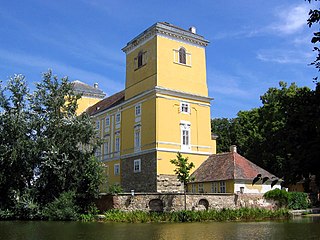
Wolkersdorf im Weinviertel is a town in the district of Mistelbach in the Austrian state of Lower Austria. It is situated in the Weinviertel, about 15 km north of Vienna, on the main road from Vienna to Brno. The municipality consists of the subdivisions Wolkersdorf, Riedenthal, Pfösing, Obersdorf and Münichsthal. It was elevated to town status in 1969.
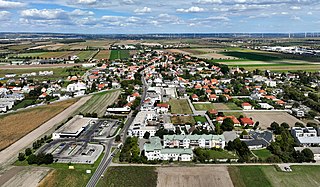
Gerasdorf bei Wien is a town in the district of Korneuburg in the Austrian state of Lower Austria. The city has 10,862 inhabitants.

Wiener Neustadt Hauptbahnhof is a railway station in Wiener Neustadt, in the federal state of Lower Austria, south of Vienna. With over 700 trains and 25,000 passengers each day, the station is the busiest in Lower Austria.

The Southern Railway is a railway in Austria that runs from Vienna to Graz and the border with Slovenia at Spielfeld via Semmering and Bruck an der Mur. Along with the Spielfeld-Straß–Trieste railway, it forms part of the Austrian Southern Railway that connected Vienna with Trieste, the main seaport of the Austro-Hungarian Monarchy, via Ljubljana. A main obstacle in its construction was getting over the Semmering Pass over the Northern Limestone Alps. The twin-track, electrified section that runs through the current territory of Austria is owned and operated by Austrian Federal Railways (ÖBB) and is one of the major lines in the country.
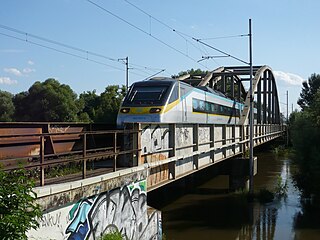
The North railway line is a two-track, electrified railway line that runs 83.1 kilometres (51.6 mi) from Vienna, Austria to Břeclav, Czech Republic. It was built by the Emperor Ferdinand North Railway company as a part of the Warsaw-Vienna railway.

Line U1 is a line on the Vienna U-Bahn metro system. Opened in 1978, it currently has 24 stations and a total length of 19.3 km (12.0 mi), from Oberlaa to Leopoldau. When the extension to Oberlaa was completed in 2017, the line became the longest on the network, surpassing the length of U6.

Line U4 is a line on the Vienna U-Bahn metro system. Opened in 1976, it currently has 20 stations and a total length of 16.5 km (10.3 mi), from Hütteldorf to Heiligenstadt. It is connected to U1 at Karlsplatz and Schwedenplatz, U2 at Schottenring, U3 at Landstraße, U6 at Längenfeldgasse and Spittelau.

Line U6 is a line on the Vienna U-Bahn. It currently has 24 stations and runs 17.3 km from Floridsdorf to Siebenhirten. It is connected to U4 at Längenfeldgasse, U3 at Westbahnhof and U4 at Spittelau. The first section of the line opened in 1989, and was completed at its present length in 1996. It is the only metro line in the DACH countries which is not operated by third rail but by overhead wire; this is because the centre portion of the line is an elevated part of the former Vienna Stadtbahn system, which was operated by overhead wire.

The EN 234/235, until 2013 named Allegro Tosca, is an overnight train jointly operated by the Austrian Federal Railways and Trenitalia under the EuroNight brand. It runs 1,203 km (748 mi) from Wien Hbf in Vienna to Roma Termini in Rome, with thru-cars to Milano Centrale in Milan.
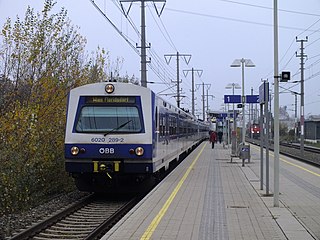
S7 is an electrified commuter rail service operating between Floridsdorf and Vienna International Airport, with extended eastbound service to Wolfsthal in the greater Vienna area and northbound service to Laa an der Thaya, sometimes ending in Wolkersdorf and Mistelbach. Between Wien Mitte and the airport, S7 provides local service on the route while the City Airport Train provides non stop express service to the airport. The S7 uses the former Aspangbahn right-of-way in the city center then, at Kledering, transitions to the former Pressburger Bahn, which connected Vienna and Bratislava, to Wolfsthal. Average travel time between Floridsdorf and Vienna International Airport is 37 minutes.
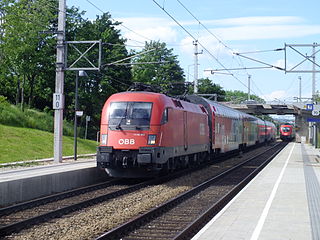
R 510/900 is a commuter/regional rail service operating between Wiener Neustadt and Bernhardsthal with extended service to Břeclav in the Czech Republic. R 510 and R 900 are two separate services that run interchangeably allowing direct service between the two points. The service is operated by the Austrian Federal Railways (ÖBB) in cooperation with VOR. R 510 begins at Wiener Neustadt Hauptbahnhof in the south and travels to Vienna along the Southern Railway (Südbahn), the busiest railway in Austria. North of Vienna, most trains switch to the R 900 route. R 900 service uses the Northern Railway (Nordbahn) to Bernhardsthal and Breclav.

Vienna Airport is a railway station serving Vienna International Airport in Schwechat, Lower Austria, Austria. The train services are operated by ÖBB and Deutsche Bahn.

The Laaer Ostbahn is a railway line in Lower Austria. It runs 82.6 kilometres (51.3 mi) from Wien Hauptbahnhof to Laa an der Thaya, on the Czech–Austrian border. The line formerly continued to Brno. Austrian Federal Railways (ÖBB) owns and operates the line.

The Verbindungsbahn, also known as the Stammstrecke, is a railway line in Vienna, Austria. It runs 16.2 kilometres (10.1 mi) across Vienna, roughly east–west, connecting with most major railway lines in the vicinity of Wien Hauptbahnhof. The section between Wien Praterstern and Wien Meidling, along with part of the North railway line, hosts most Vienna S-Bahn services.
